Winter Moon of the Long Nights
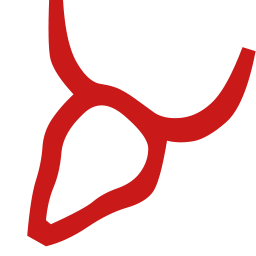 Kabbalah last night. The first session of Mystical Hebrew Letters. Rabbi Jamie began teaching kabbalah at the Kabbalah Experience with this class several years ago. It moves from the broader conceptual fields of Soul and Space, the first two classes this year, to the particular examination of the Hebrew alphabet.
Kabbalah last night. The first session of Mystical Hebrew Letters. Rabbi Jamie began teaching kabbalah at the Kabbalah Experience with this class several years ago. It moves from the broader conceptual fields of Soul and Space, the first two classes this year, to the particular examination of the Hebrew alphabet.
As with all the kabbalistic material, the subject matter gets complicated fast. We began with an overview of this ancient language. According to recent scholarship Rabbi Jamie says, it is the oldest alphabet in the world. Like most early languages, Chinese for example, it began as pictographs.
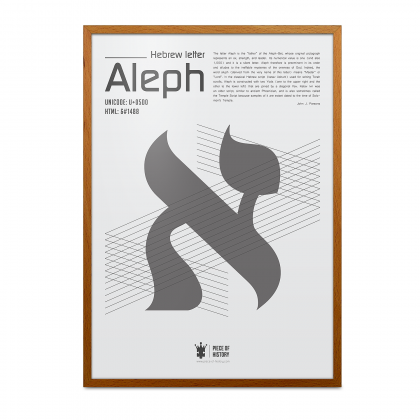 Aleph, the first letter, was an ox-head. The word aleph means ox-head, or head of ox, also learning and chieftain. Prior to the use of Arabic numerals each Hebrew letter stood in for numbers with the letter aleph as number one. The word aleph means 1,000. Thus, aleph symbolizes the philosophical notion of the one and the many.
Aleph, the first letter, was an ox-head. The word aleph means ox-head, or head of ox, also learning and chieftain. Prior to the use of Arabic numerals each Hebrew letter stood in for numbers with the letter aleph as number one. The word aleph means 1,000. Thus, aleph symbolizes the philosophical notion of the one and the many.
It is silent. Not sure why, but aleph and ayin, though used in the written language, are always silent. As silent and first in the alphabet, it also symbolizes the silence out of which came everything.
(next day) Stopped writing this yesterday when my need for sleep overcame my ability to write a coherent sentence.
The big idea I took away from this class involved aleph and my reimagining/reconstructing emphasis on incarnation rather than transcendence. Jamie introduced the notion of the alphabet, the Hebrew alphabet, as a funnel flowing from aleph in the ein sof (unlimitedness), its silence standing for the space created when the ein sof contracted, the tzimtzum, and filled with ohr, the first light of creation which fractures and travels down through the tree of life with its 22 channels (connecting lines) to the tenth sephirot, or malchut/shekinah, which is this world. Its letter is tav, the 22nd and last letter.
At first I thought, oh this emphasizes transcendence, the physical world developing in a top down fashion from a realm unconnected to it save by the thinnest of conceptual threads. Then Jamie began to introduce the location of the letters on the tree of life and aleph did not appear above the keter (the crown at the top of the tree of life), but on the parallel line of connection between chesed and gevurah, essentially the middle of the tree of life. Huh? How could this be?
These two images represent the two different ways of understanding this idea:
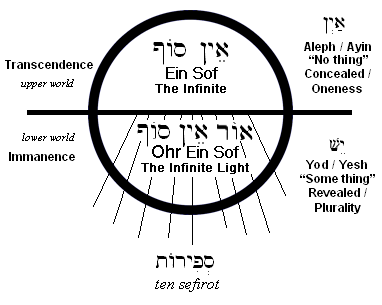
This one shows the first representation of the funnel idea that came to me. It does in fact emphasize transcendence. But, when we remember (difficult to do when material is presented on paper) that the tree of life is three-dimensional and can be seen as a sphere, another possible image presents itself.
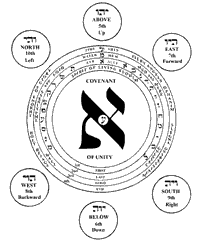
As the rabbi likes to say, Aha! The nub of creation, the contraction of the unlimited ein sof, the movement from the quantum world to the Einstenian/Newtonian this world, the shattering of the ur-ohr, the first light of creation, happens in the center of the sphere and radiates outward. Yes. The divine moves from within all to create, in an outward push, the shekinah, the divine manifested in created matter. This is big-bangy. The tzimtzum just proceeds the big bang which radiated outward from an unfathomably concentrated spot in the beforeness of whatever it was, the ein sof, to create literally everything we know.
This puts the sacred neither above nor below but within. In order to access sacred nature we do not need to cast a prayer upward toward the heavens or outward to a religious institution, but inward to the aleph in our own soul, to that silent spot in ourselves where resides our shard of the ohr, the first light.
Here is an image of the tree of life that shows the location of aleph between chesed and gevurah. Remember that the tree is three dimensional like the DNA helix.
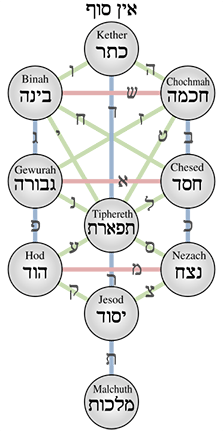

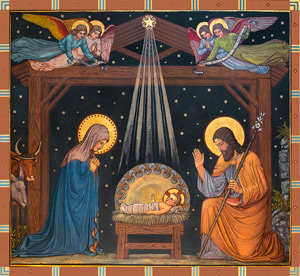
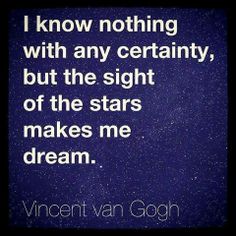 Inside the particular Jewish or Presbyterian or Unitarian or New Thought or Tibetan Buddhist or Hindu or Muslim community to which we belong we use this language and create a sense of belonging. As we use the language, part of which is ritual and dress, part of which is expected behaviors, we create a semi-permeable membrane, often not very permeable at all, for outsiders. To cross into our community they have to penetrate the language, learn the customs, adjust themselves to the patterns. The membrane works both ways, obscuring our vision as we look out from within our particular tradition. We see a world shaped by and often determined by the assumptions of ours.
Inside the particular Jewish or Presbyterian or Unitarian or New Thought or Tibetan Buddhist or Hindu or Muslim community to which we belong we use this language and create a sense of belonging. As we use the language, part of which is ritual and dress, part of which is expected behaviors, we create a semi-permeable membrane, often not very permeable at all, for outsiders. To cross into our community they have to penetrate the language, learn the customs, adjust themselves to the patterns. The membrane works both ways, obscuring our vision as we look out from within our particular tradition. We see a world shaped by and often determined by the assumptions of ours.


 We have a cookbook, Twelve Months of Monastery Soups, and I’ve been making soups out of it that Kate thinks sound good. She has a favorite, vermicelli soup, a vegetable soup with noodles. I made some for her last night.
We have a cookbook, Twelve Months of Monastery Soups, and I’ve been making soups out of it that Kate thinks sound good. She has a favorite, vermicelli soup, a vegetable soup with noodles. I made some for her last night. Full day yesterday. Up at 4:45 though Kep had nudged Kate awake earlier and she’d already fed the dogs. Wrote, ate breakfast, came back to the loft and filed all my open tabs in Evernote. That took a while since I’m still fiddling with Firefox Quantum, too, changing zoom levels, color preferences, customizing the tool bar. Got to the new workout from On the Move Fitness about 9:30. Finished, after icing my knee, at 11:00.
Full day yesterday. Up at 4:45 though Kep had nudged Kate awake earlier and she’d already fed the dogs. Wrote, ate breakfast, came back to the loft and filed all my open tabs in Evernote. That took a while since I’m still fiddling with Firefox Quantum, too, changing zoom levels, color preferences, customizing the tool bar. Got to the new workout from On the Move Fitness about 9:30. Finished, after icing my knee, at 11:00.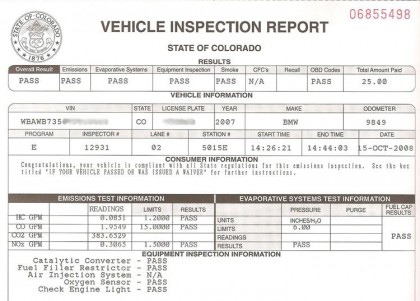 So I asked the technician. Turns out the specific tests at drive through testing facilities like the one I visited yesterday use a very specific algorithm, putting the car on rollers and then simulating different traffic conditions. The VW scam depended on the very specific, and standard, testing algorithm. They taught their cars to blow clean during the exact kind of testing done at state and county testing facilities.
So I asked the technician. Turns out the specific tests at drive through testing facilities like the one I visited yesterday use a very specific algorithm, putting the car on rollers and then simulating different traffic conditions. The VW scam depended on the very specific, and standard, testing algorithm. They taught their cars to blow clean during the exact kind of testing done at state and county testing facilities.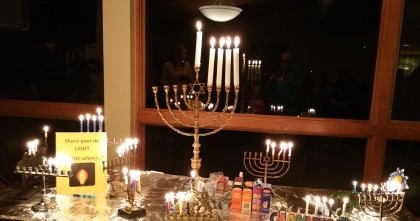 Nap-ish. Kate made a pasta dish with chard, yummy, for the Beth Evergreen potluck. A Hanukkah shabbat service. We all brought our family menorahs with four candles, put them on one table and lit them. Rabbi Jamie lit the much larger Synagogue menorah. We sang songs, including dreidel, dreidel, dreidel, I made it out of clay and others unfamiliar to me. There were tables in the sanctuary and we ate the meal there.
Nap-ish. Kate made a pasta dish with chard, yummy, for the Beth Evergreen potluck. A Hanukkah shabbat service. We all brought our family menorahs with four candles, put them on one table and lit them. Rabbi Jamie lit the much larger Synagogue menorah. We sang songs, including dreidel, dreidel, dreidel, I made it out of clay and others unfamiliar to me. There were tables in the sanctuary and we ate the meal there. After writing the post below, about slowing down, I realized I need a vacation. Time off. A break. A pause. I need to vacate the life I love for just a bit, to clear out the schmuz in my pistons. Confess I don’t know how to do that right now. Money. Visitors. Holidays. I’m considering how to do it.
After writing the post below, about slowing down, I realized I need a vacation. Time off. A break. A pause. I need to vacate the life I love for just a bit, to clear out the schmuz in my pistons. Confess I don’t know how to do that right now. Money. Visitors. Holidays. I’m considering how to do it. Afterward, kabbalah. Three presentations. One on the idea of the holy of holies. The temple looms large in Jewish thought, in many, many ways. One on the link between the ten sefirot and a Japanese inspired version of Chinese medicine, acupressure. One on the surprisingly pervasive influence of the kabbalists in the shabbat service. All were, in their own way, interesting. Having to come up with a presentation did cement the learning for each of us, that was clear. And, they led to interesting speculations.
Afterward, kabbalah. Three presentations. One on the idea of the holy of holies. The temple looms large in Jewish thought, in many, many ways. One on the link between the ten sefirot and a Japanese inspired version of Chinese medicine, acupressure. One on the surprisingly pervasive influence of the kabbalists in the shabbat service. All were, in their own way, interesting. Having to come up with a presentation did cement the learning for each of us, that was clear. And, they led to interesting speculations.
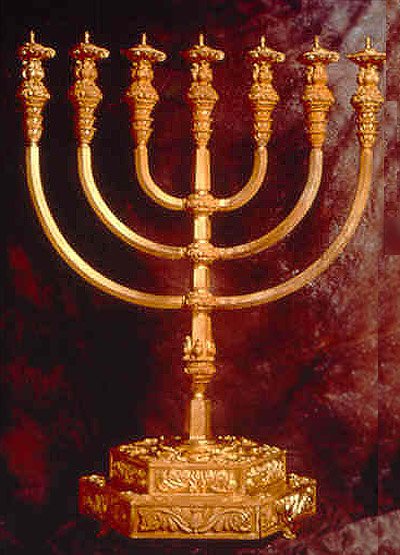
 Wednesday, adult Hebrew at 4:30 with Rabbi Jamie. Then, kabbalah at 7 p.m. Thursday. Mussar at 1 pm. Then mussar leadership group at 6:30 p.m. Result? Both nights up past my bedtime and an 8 a.m. rising this morning. Oooffdah, as we would have said back in the land of the frozen mustache.
Wednesday, adult Hebrew at 4:30 with Rabbi Jamie. Then, kabbalah at 7 p.m. Thursday. Mussar at 1 pm. Then mussar leadership group at 6:30 p.m. Result? Both nights up past my bedtime and an 8 a.m. rising this morning. Oooffdah, as we would have said back in the land of the frozen mustache. Judaism is humane and that aspect of it appeals to me. A lot. Example. Rich Levine, the lawyer who did our estate documents, attended the MVP meeting last night. He had, he said, with his brother just unveiled his father’s gravestone. Is this a common custom, I asked? Yes, he said, most if not all Jews follow it. A loved one is buried, then not more than a year later, a gravestone is erected. The wait considers a journey the deceased needs to make that can last as long as a year. But, Rich said, you don’t want to make them think that you think it would take them a whole year, so usually the gravestone goes up somewhere between 10 and 11 months after burial. Much less fraught then.
Judaism is humane and that aspect of it appeals to me. A lot. Example. Rich Levine, the lawyer who did our estate documents, attended the MVP meeting last night. He had, he said, with his brother just unveiled his father’s gravestone. Is this a common custom, I asked? Yes, he said, most if not all Jews follow it. A loved one is buried, then not more than a year later, a gravestone is erected. The wait considers a journey the deceased needs to make that can last as long as a year. But, Rich said, you don’t want to make them think that you think it would take them a whole year, so usually the gravestone goes up somewhere between 10 and 11 months after burial. Much less fraught then.
 CC’s work with Maslow sparked a conversation about the difference between human agency in moving up the pyramid as opposed to the necessity of God’s agency. Within my worldview this is a false dichotomy, but the conversation was fruitful. It’s a false dichotomy to me for two reasons. 1. How else would God move someone up the pyramid save through human agency? 2. Since I see energy moving up and down the tree of life, from the invisible to the visible and back through the visible to the invisible, this energy flow is the key agency involved, imh. I might call it chi, or prana, or l’chaim. Could also call it divine or vitality or consciousness. I don’t see that adding God to the conversation accomplishes much.
CC’s work with Maslow sparked a conversation about the difference between human agency in moving up the pyramid as opposed to the necessity of God’s agency. Within my worldview this is a false dichotomy, but the conversation was fruitful. It’s a false dichotomy to me for two reasons. 1. How else would God move someone up the pyramid save through human agency? 2. Since I see energy moving up and down the tree of life, from the invisible to the visible and back through the visible to the invisible, this energy flow is the key agency involved, imh. I might call it chi, or prana, or l’chaim. Could also call it divine or vitality or consciousness. I don’t see that adding God to the conversation accomplishes much. In the end I felt heard and honored for my understanding of the relationship between the cyclical turn of the seasons and the meaning of the tree of the life to kabbalists.
In the end I felt heard and honored for my understanding of the relationship between the cyclical turn of the seasons and the meaning of the tree of the life to kabbalists. Since I have long believed that the world’s religions are philosophy and poetry accessible to all, I remain eager to learn from them. Since I know their claims cannot all be true, I choose to remain outside them, yet to walk with them as part of my journey. During college, when fellow students were turning to Asian faiths: the hare krishnas, zen, tibetan mysticism, I believed that the religious traditions of the West were most culturally attuned to the American mind. I still believe that and find Judaism and its traditions and thoughts, like Christianity, trigger a depth of understanding I don’t get from the Asian faiths.
Since I have long believed that the world’s religions are philosophy and poetry accessible to all, I remain eager to learn from them. Since I know their claims cannot all be true, I choose to remain outside them, yet to walk with them as part of my journey. During college, when fellow students were turning to Asian faiths: the hare krishnas, zen, tibetan mysticism, I believed that the religious traditions of the West were most culturally attuned to the American mind. I still believe that and find Judaism and its traditions and thoughts, like Christianity, trigger a depth of understanding I don’t get from the Asian faiths. Think I’ve figured out my kabbalah presentation. Still a bit rough around the edges but that’s going to be part of it. It’ll be a how to think with the tree of the life as a touchstone example, using the Great Wheel as an instance.
Think I’ve figured out my kabbalah presentation. Still a bit rough around the edges but that’s going to be part of it. It’ll be a how to think with the tree of the life as a touchstone example, using the Great Wheel as an instance.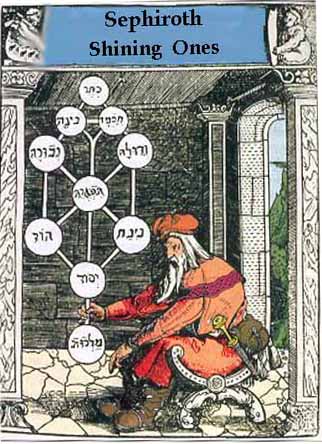 This a crucial difference between a secular, scientific world view and a mystical one. Entropy posits, as I mentioned in a post not long ago, that all things die, including death, I suppose. The Great Wheel and the tree of life challenge that grim metaphysics with an alternative.
This a crucial difference between a secular, scientific world view and a mystical one. Entropy posits, as I mentioned in a post not long ago, that all things die, including death, I suppose. The Great Wheel and the tree of life challenge that grim metaphysics with an alternative.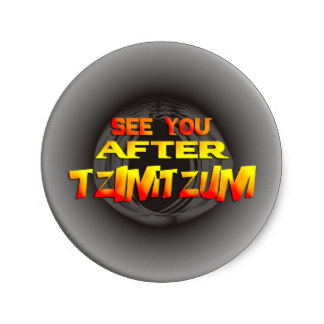 God became fractionated during the tzimtzum, the contraction of divine energy that made the finite possible. This idea is still difficult for me, but I’m just accepting it for the purposes of this presentation. During the tzimtzum the infinite light, ohr, tried to manifest in the finite, filling the space created by the contraction, but the vessel, things, (ein sof = no-things, infinity) could not hold it and shattered. That shattering created all the elements that now make up our universe. (and other universes, too) Trapped inside all of these elements is the ohr. The ascent and descent of divine energy, from the keter to malchut and backup through the sephirot to the keter from malchut, is the way the ohr will once again join with the infinite. How? No clue.
God became fractionated during the tzimtzum, the contraction of divine energy that made the finite possible. This idea is still difficult for me, but I’m just accepting it for the purposes of this presentation. During the tzimtzum the infinite light, ohr, tried to manifest in the finite, filling the space created by the contraction, but the vessel, things, (ein sof = no-things, infinity) could not hold it and shattered. That shattering created all the elements that now make up our universe. (and other universes, too) Trapped inside all of these elements is the ohr. The ascent and descent of divine energy, from the keter to malchut and backup through the sephirot to the keter from malchut, is the way the ohr will once again join with the infinite. How? No clue.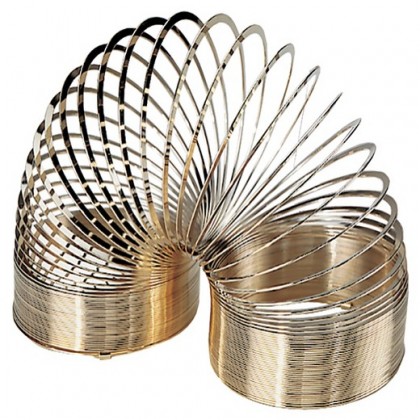 This is a malchutian manifestation, I think, of the ascent and descent and ascent again of divine energy represented by the tree of life. Why? Well, until the divine energy passes through yesod and becomes real in malchut, it is hidden, invisible, just like the vivifying function of the soil and the air and the sun is hidden during the fallow time. Both represent the cyclical nature of things coming into existence from apparent no-thing, then returning themselves to the invisible, the hidden.
This is a malchutian manifestation, I think, of the ascent and descent and ascent again of divine energy represented by the tree of life. Why? Well, until the divine energy passes through yesod and becomes real in malchut, it is hidden, invisible, just like the vivifying function of the soil and the air and the sun is hidden during the fallow time. Both represent the cyclical nature of things coming into existence from apparent no-thing, then returning themselves to the invisible, the hidden.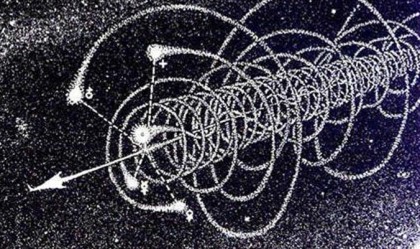 The slinkys I will hand out, tiny one-inch ones, illustrate what I mean. The Great Wheel turns through one year, one orbit around the sun, then repeats and is, in that, cyclical and not chronological. But, if you link this orbit to that one we get a spiral as our rapidly moving planet follows our solar system around the galaxy at unimaginable rates of speed. The Great Wheel then extends in space, in a spiral, this year’s revolution becoming another while the whole planet and its sun captive neighbors push further and further around the Milky Way. And, just to add complexity, as the whole galaxy moves, too.
The slinkys I will hand out, tiny one-inch ones, illustrate what I mean. The Great Wheel turns through one year, one orbit around the sun, then repeats and is, in that, cyclical and not chronological. But, if you link this orbit to that one we get a spiral as our rapidly moving planet follows our solar system around the galaxy at unimaginable rates of speed. The Great Wheel then extends in space, in a spiral, this year’s revolution becoming another while the whole planet and its sun captive neighbors push further and further around the Milky Way. And, just to add complexity, as the whole galaxy moves, too.